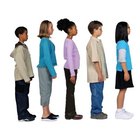The Beatitudes are a series of of eight phrases that were uttered by Jesus, explaining how Christians should act toward others and themselves. The Beatitudes are taught to children within the Catholic Church as a part of their training leading to their first communion. Teachers can use activities to help the children learn and memorize the Beatitudes for the purpose of their first communion and to carry with them for the rest of their lives.
Mix and Match
Create cards for the children to put into order to create each Beatitude. Write each word from all of the Beatitudes onto 4-by-6-inch index cards. Then mix up the cards so that they are no longer in order. Instruct the children to put the cards in order to form each of the Beatitudes or one particular Beatitude.
Posters
Older children may enjoy putting together posters or drawings to represent each of the Beatitudes. Help students find copyright-free images to use for their posters or ask them to draw a picture to match each Beatitude. Have each student create all eight posters for herself or split the class up into eight groups and assign each group one of the Beatitudes. If you split the class up into groups, you can display the results either in the classroom, in the hallway of the school or in the church for all to enjoy.
Fill in the Blanks
After you have taught the Beatitudes to the class and requested that they memorize them, test their memorization with a fill-in-the-blanks quiz. Write the Beatitudes on the board, leaving some of the words blank. You can give younger kids a list of words to use in the blanks. Older kids can supply the missing words themselves. Repeat this exercise every couple of weeks to check their understanding of the material.
Beatitude Telephone
Call one child to the front of the room and whisper a little-known fact about the Beatitudes to the child so that no one else in the class can hear. Say the fact only once. Call another child up and the first child must whisper the fact to the second child in his own words. The fact may only be told by each person once. Repeat this process until the final child has heard the fact. The final child should say aloud what she has been told. If the child is correct, it shows the children are able to pass on information successfully. However, if the final child is wrong, you can use this as a lesson on how messages can be altered over time when being passed from person to person.
Related Articles

Crafts for Teaching Beatitudes to ...

Children's Games That Demonstrate Faith

Bible Games on Psalms for Kids

Games to Play for Teaching the ...

Faith Building Games for Children

Exercises for Verbal Communication ...

Get Acquainted Activities for Adults

Follow-the-Leader Children's Games

Games for Family Communication

Activities to Teach Children to Hear ...

Children's Activities for Jeremiah ...

Valentine's Day Party Games for School- ...

How to Play Baby Outburst Game for Baby ...

Middle School Bible Games

Fun Activities for Kids Who Are Dealing ...

How to Play a Trivia Game at a Birthday ...

How to Make a Bar Mitzvah Service ...

Decision & Consequences Games for ...

Bible Games for Seventh Day Adventist

Characteristics of Fables for Kids
References
Writer Bio
Kimberly Turtenwald began writing professionally in 2000. She has written content for various websites, including Lights 2 You, Online Consultation, Corpus Personal Injury and more. Turtenwald studied editing and publishing at Wisconsin Lutheran College.